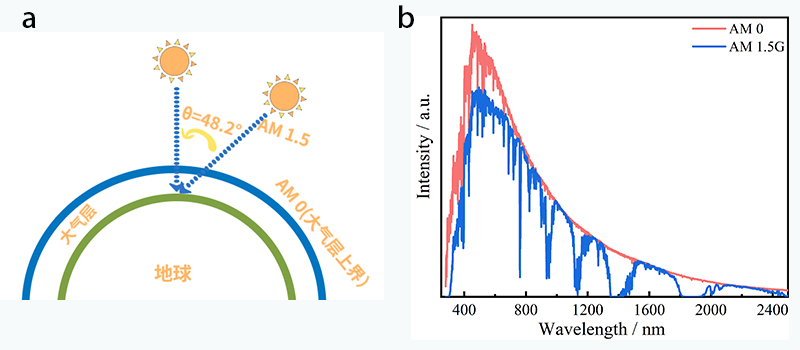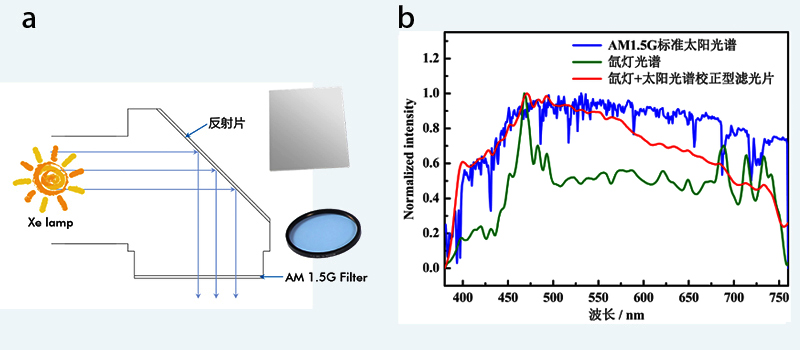Creating original content is not easy. If you wish to reproduce this article, please contact the staff and provide proper attribution in the republished article; otherwise, infringement actions will be taken!
I believe you have come across descriptions like "Xenon lamp source with AM 1.5G filter" in many documents, indicating the use of a xenon lamp source with an AM 1.5G filter. But do you know what AM 1.5G actually means? And how is the AM1.5G solar spectrum obtained?

Figure 1. Example of Microsolar 300 Xenon Lamp Source[1] and PLS-SXE 300D Xenon Lamp Source[2] with AM 1.5G Filter
As sunlight travels through space and the Earth's atmosphere to reach the Earth's surface, its irradiance gradually diminishes. In order to quantify the degree of attenuation in solar radiation, the term "air mass" (abbreviated as AM) is often used for labeling[3].
When the angle between the incident sunlight and the ground normal is denoted as θ, the relationship between AM and θ can be expressed as: AM = 1/cosθ, as shown in Figure 2.

Figure 2. AM 0, AM 1.5 Diagrams and AM 0, AM 1.5G Spectral Graph
When θ = 48.2 degrees, it is denoted as AM 1.5, representing the scenario of sunlight shining on the Earth's surface on a typical clear day. This condition closely resembles actual human living conditions, with an irradiance of 1000 W/m2, which can also be expressed as 100 mW/cm2.
AM 1.5G refers to the standard spectrum on the Earth's surface. The "G" stands for "Global," and for the purpose of comparing solar energy conversion efficiency measured at different times and locations, AM 1.5G is defined as the reference spectrum for standard testing of solar energy conversion systems[4]. The standard irradiance of AM 1.5G is set at 100 mW/cm2.
In photochemical experiments, to obtain the AM 1.5G standard solar spectrum, a common approach is to use a xenon lamp source paired with an AM 1.5G filter as a simulated light source for the sun.
Xenon Lamp Source is a light source that emits light through the discharge of high-pressure or ultra-high-pressure xenon gas. It produces a continuous spectrum with energy distribution ranging from 200 to 2000 nm, and its energy distribution characteristics closely resemble those of the solar spectrum.
However, xenon lamp sources have significant deviations in the infrared region compared to the solar spectrum. Therefore, to obtain the AM 1.5G standard solar spectrum, a xenon lamp source needs to be used in conjunction with a solar spectrum correction filter, which consists of an AM 1.5G filter and a total reflection filter.

Figure 3. Xenon Lamp Source Optical Path Diagram (Left), Microsolar 300 Xenon Lamp Source with AM 1.5G Filter Spectral Graph and AM 1.5G Standard Solar Spectrum (Right)
The total reflection filter, also known as a total reflector, reflects all emitted light from the xenon lamp as incident light. Its operational wavelength range is from 200 to 1200 nm, and its optical characteristics include: R > 80%@200-300nm, R > 85%@300-650nm, R > 90%@950-1200nm, and R > 75% at the wavelength low point of 800nm (±25nm). The AM 1.5G filter and total reflection filter are used together to reflect the xenon lamp light and form the AM 1.5G solar spectrum.
The above sections are based on my translation and summarization of reference materials. I have limitations in my expertise, so please feel free to correct any errors.
[1] Li Yinyin, Wu Qiannan, Xie Tengfeng*, et. al. Interface engineering Z-scheme Ti-Fe2O3/In2O3 photoanode for highly efficient photoelectrochemical water splitting[J], Applied Catalysis B: Environmental, 2021, 290, 120058.
[2] Ning Xingming, Du Peiyao*, Lu Xiaoquan*, et. al. Plasmon-enhanced charge separation and surface reactions based on ag-loaded transition-metal hydroxide for photoelectrochemical water oxidation[J], Advanced. Energy Materials. 2021, 2100405.
[3] Li Can. Solar Energy Conversion Science and Technology [M]. Beijing: Beijing Science Press,2020: 148.
[4] ASTM G173 - 03(2012) Standard Tables for Reference Solar Spectral Irradiances: Direct Normal and Hemispherical on 37° Tilted Surface.